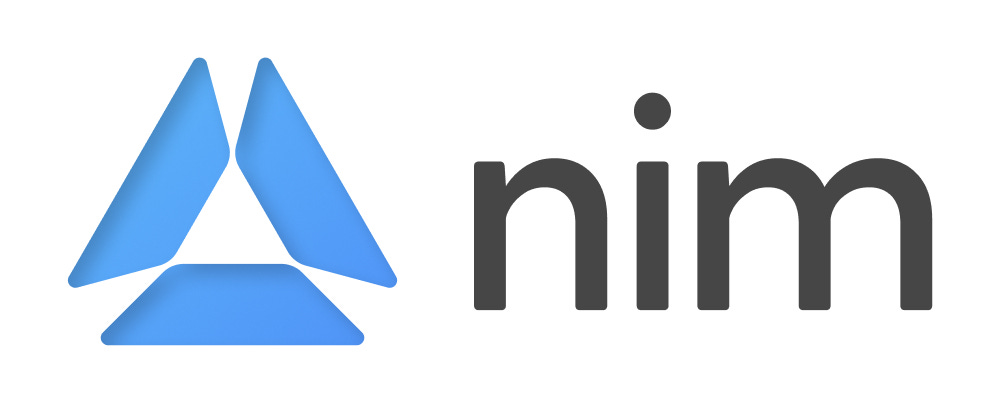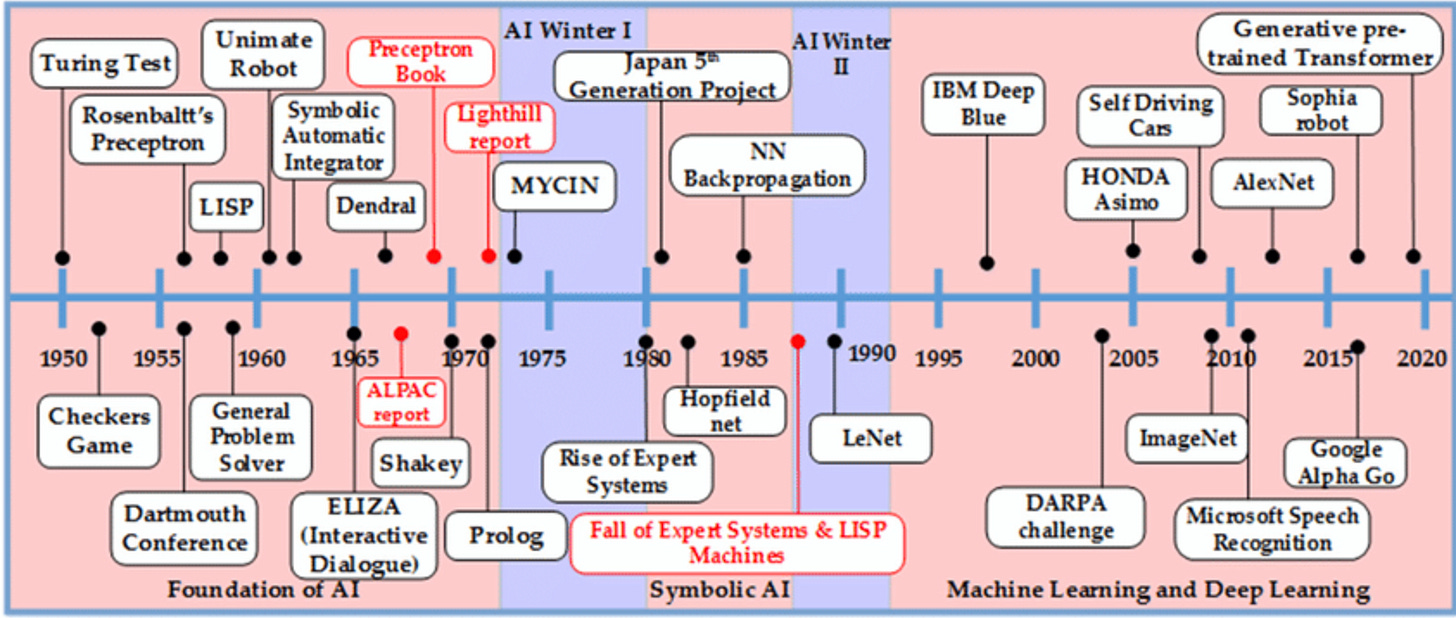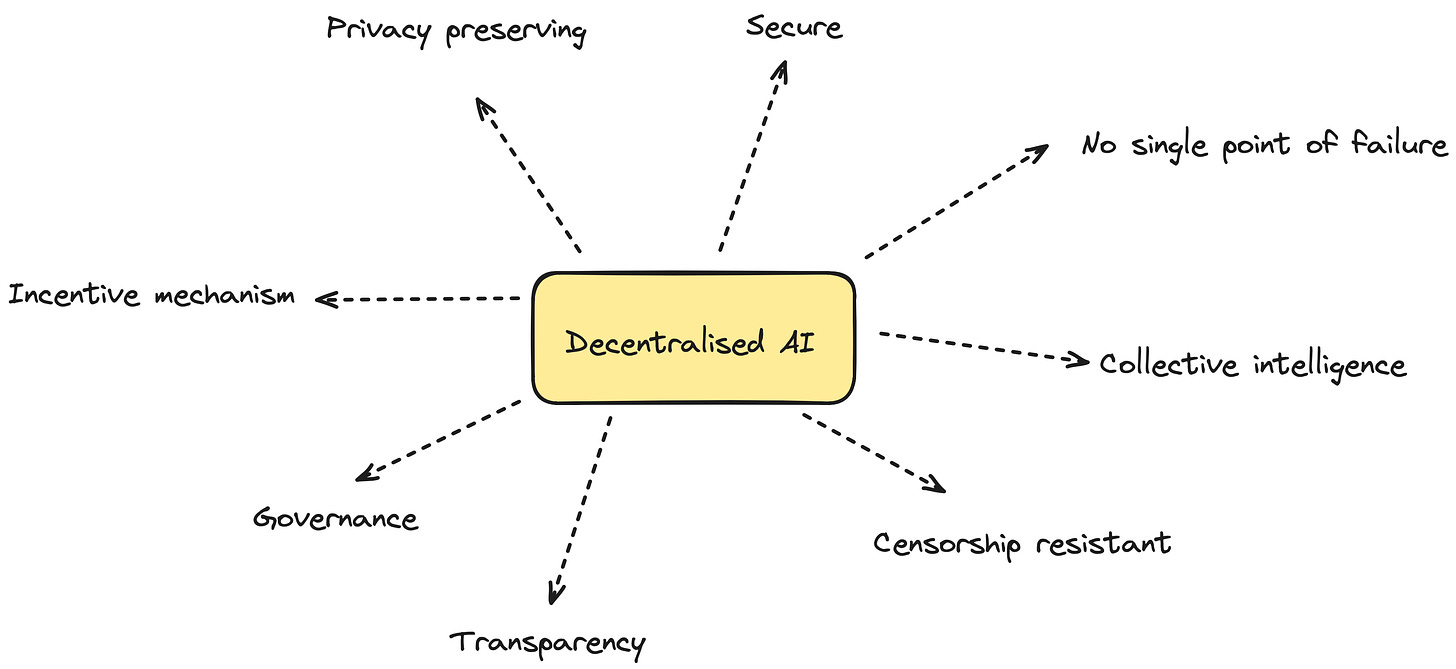What is Decentralized AI (DeAI) all about?
Today we'll explore what DeAI is all about and why it matters. We'll also dive into how we think this ecosystem will grow in the future, along with some of today's key apps from this domain.
In today’s post, we’ll be covering the world of Decentralized AI (DeAI). We’ll look at:
AI’s development lifecycle
The need for decentralized AI
Practical applications of DeAI
Growth catalysts for the Crypto x AI space
Visionaries leading the front
What’s not so great about DeAI
& the future of Crypto x AI
Before we begin, however, we’d like to thank the sponsor of today’s post, Nim Network.
Nim Network is building the future of AI gaming and consumer applications in crypto, creating in its chain an ecosystem that connects ownership with the funding of open-source AI and applications.
Introduction to AI
I think it’s safe to say that, Artificial Intelligence (AI) is set to transform the world. Imagine a child learning to recognize animals by looking at pictures, learning their names, and remembering their features. Over time, the child improves at identifying animals.
AI operates in a similar manner, using data to learn and enhance its performance over time.
There have been numerous breakthrough applications built with AI, some of which include 👇
ChatGPT: Capable of holding human-like conversations.
Perplexity AI: Improves search accuracy.
Jasper AI: Acts as your co-pilot for content writing.
DALL-E: Generates images from textual descriptions.
Pika Art: Produces high-definition videos from text.
The list goes on and on - here’s a great list to help you keep track of this ever-growing AI ecosystem.
These tools are becoming part of our daily lives, making tasks easier and more efficient. AI is not just a futuristic concept; it actively addresses significant problems we face today.
AI’s growth is transforming numerous industries, such as:
Helping doctors diagnose diseases faster
Enabling self-driving cars to navigate safely
Personalizing shopping experiences for users online

In principle, AI approaches can be divided into three major categories:
Centralized AI: Controlled by singular entities or enterprises.
Decentralized AI: Focuses on distributed control, transparency, and incentives.
Open-source AI: Emphasizes promoting collaboration and transparency.
In today’s research, we’ll specifically explore “Decentralized AI.”
AI’s development life cycle
Before we dive into the details, let’s understand the different components that shape the AI development lifecycle.
This will make it easier to understand how decentralization contributes to each of these steps.
Innovations in AI require advancements, continuous feedback, training, and engagement over the years.

Developing an AI model involves several critical stages to ensure a robust end-to-end flow of operations. Here’s a detailed look at the key stages of the lifecycle:
Problem Statement Identification and Design 🎯
It all starts with identifying the business problem and defining the goals to be solved.
Data collection is one of the most critical steps, ensuring that the model consumes relevant and accurate data.
Data Gathering and Exploration 🔍
This stage involves aggregating data from various sources and evaluating its quality.
Initial data analysis helps understand patterns and trends, leading to the creation of a plan for data preprocessing and feature engineering [data improvement].
Data Wrangling and Preparation 🧹
Data preprocessing involves cleaning and transforming raw data into a rich, usable dataset.
Using feature engineering for creating new features from existing data to enhance the model’s performance.
Model Development 🛠️
This phase involves selecting the best-suited machine learning practices based on the problem statement and the data collected.
The next step is training and testing the model to ensure it can make accurate predictions.
Last is optimization, which involves improving the model’s efficiency
Model Deployment 🚀
Deploying the model into a real-world environment allows it to start making predictions, recommendations, or whatever it’s trained for. You use compute providers for putting it in production.
Continuous monitoring ensures the model remains accurate and effective.
Bias detection ensures fairness in decision-making.
Model Maintenance and Retraining 🔄
Maintaining the model involves regular updates and retraining with new data.
The focus is on gathering as much feedback as possible and sending it back to the model to adapt and enhance.
Today, most of these models come from research institutions, private companies, or a few open-source organizations. Companies like Google, OpenAI, IBM, AWS, and Microsoft are some of the major players.
Here’s a market map of GenAI models from different players across verticals 🗺️
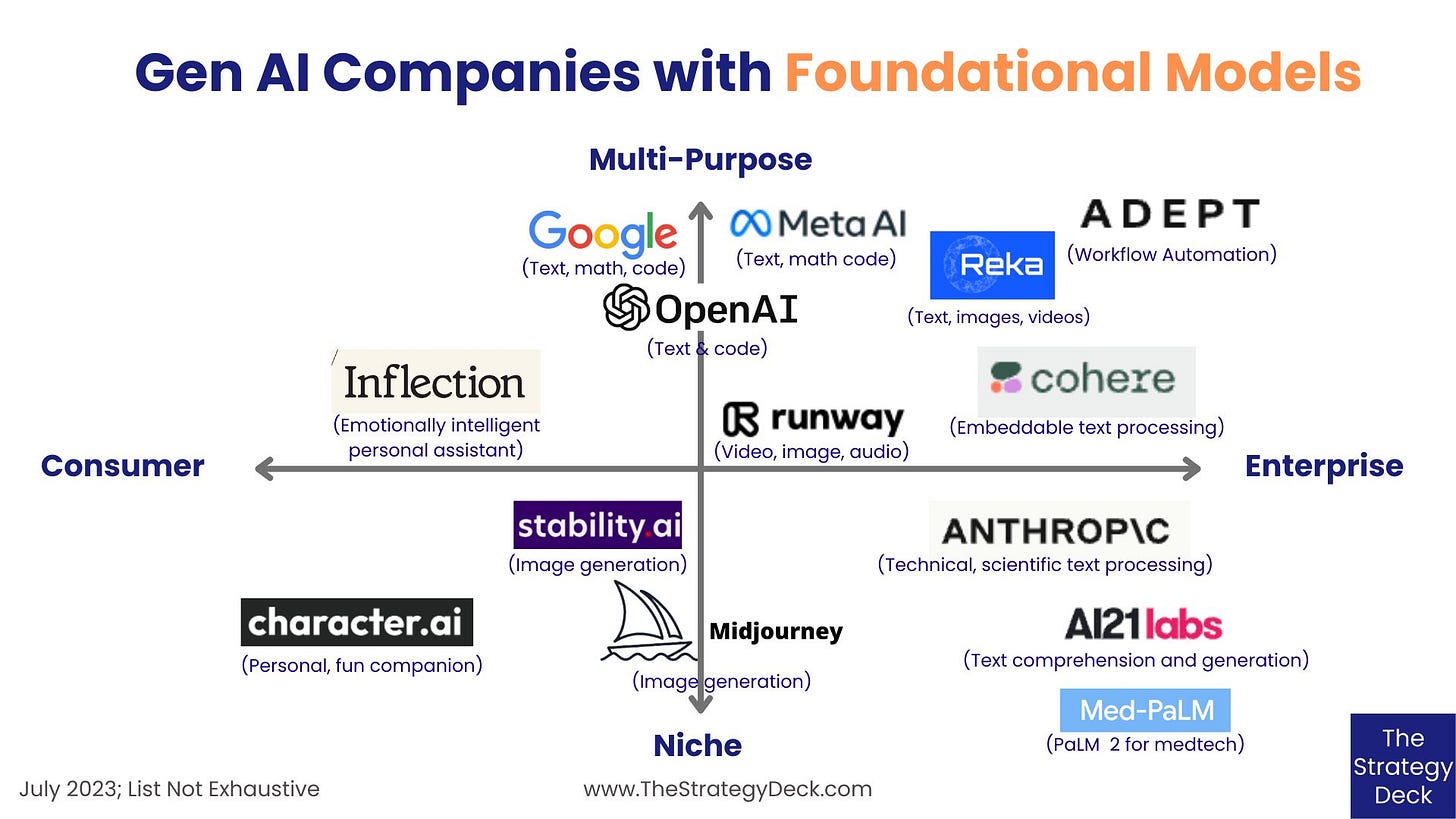
A quick overview of how the tech stack for AI has evolved over the years 👇
The Need for Decentralized AI
Centralized AI has its issues. Think about it: a single point of failure means one breach can compromise everything.
Decentralized AI (DeAI), on the other hand, changes the game by distributing data across multiple nodes, making the system more secure. If one node is attacked, the rest continue to function smoothly. This setup also gives users more control over their data, reducing privacy risks, especially when leveraging technologies like Fully Homomorphic Encryption (FHE) and Zero-Knowledge Machine Learning (ZKML).
Censorship is another significant problem with centralized systems. One entity can control and manipulate information. Decentralized AI, on the other hand, distributes control, making it harder for any single entity to dominate the narrative. This ensures information remains accessible and free from undue influence.
Transparency is a key element in my opinion. Open-source models, incentive mechanisms, and collaborative workflow management mean anyone can check and verify decisions at any time. This level of openness addresses concerns about hidden biases and opaque processes found in centralized systems. Additionally, it allows more individuals to join in and contribute. For example, someone with unused compute space can now rent it out via decentralized compute providers like Akash and Render.
A decentralized model also limits the power of central entities, preventing the misuse of AI for unfair purposes. By promoting collaboration and knowledge sharing, it leverages collective intelligence and larger governance, leading to more robust, open, and accurate systems.
Crypto acts as this enabler, bringing the best of both worlds together. It provides access to top services, compute, models, and data while also offering incentive loops, security, and privacy for every stakeholder involved. This synergy ensures that DeAI is not only effective but also fair and secure.
Practical applications of DeAI
Here are some key applications across the DeAI sector:
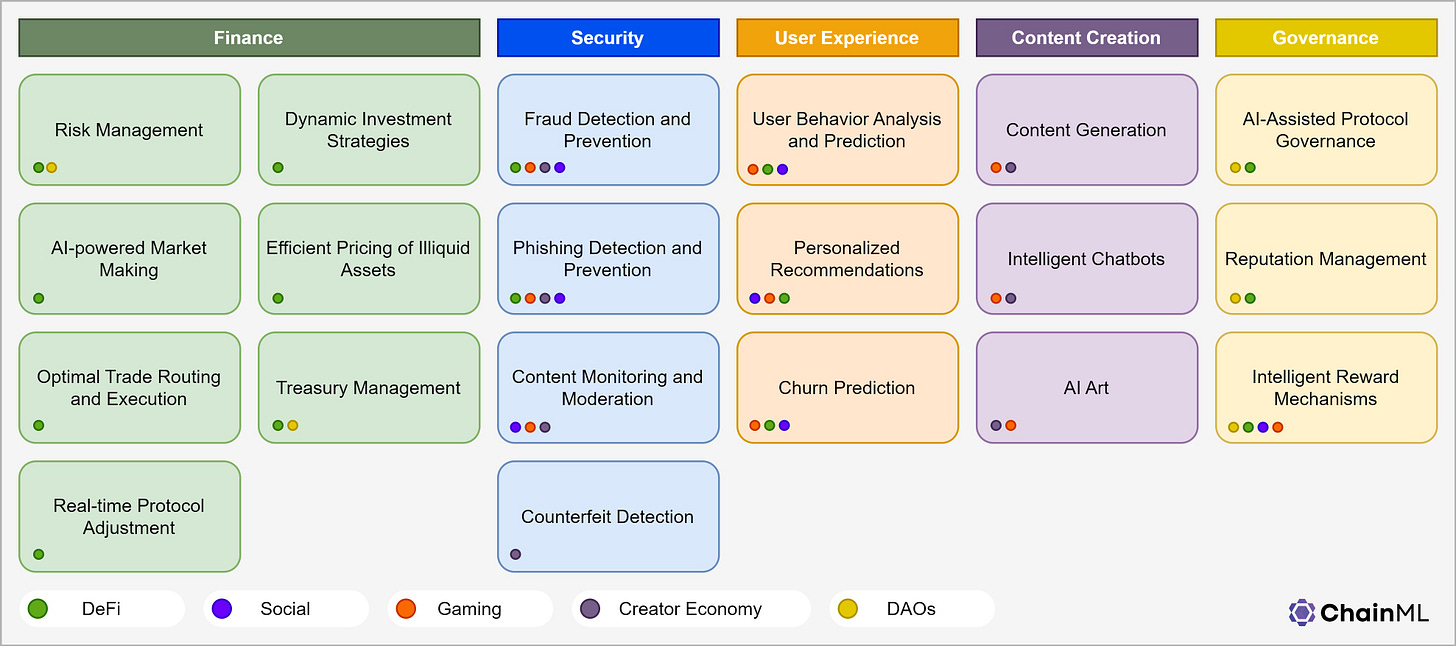
Sector wise
🏥 Healthcare
DeAI enchance healthcare by enabling secure, private data sharing among medical institutions.
AI algorithms can analyze anonymized data to identify patterns, predict disease outbreaks, and personalize treatment plans. For example, a patient can privately share their data with a hospital and be sure that only they own the data and no one else.
💹 Finance
Decentralized Finance (DeFi) is one of the largest sub-ecosystems of web3. AI can help enhance risk management and trading.
These protocols use AI to assess risks, forecast asset prices, and optimize trading strategies. For example, many projects are developing tools for effective asset management, AI-powered Automated Market Makers (AMMs), & more.
🛡️ Security and Fraud Detection
AI algorithms can help systems detect and prevent fraud by analyzing transaction data for patterns and anomalies.
This increases the security of web3 protocols. For example, in the NFT ecosystem, AI can help identify counterfeit assets, ensuring integrity.
🖌️ Content / Sentiment Generation
AI can be leveraged to create storylines, lores, game mechanics, and more.
For example, web3 games can use AI to generate game content from text descriptions, with smart contracts governing the ownership of assets like character portraits and items.
Additionally, understanding user perception of a category, problem, or market can be invaluable. Tools like Kaito and Nansen aim to provide this kind of intelligence
🤖 AI Agents and Automation
There are projects building autonomous AI agents for tasks in various domains, from customer service to supply chain management.
These agents can be created by anyone or in a collaborative effort, with all stakeholders being rewarded seamlessly in an automated fashion.
🌐 User experience
The user experience is not the best in web3, but models can help enhance this through personalized recommendations and behavior prediction.
Decentralized social networks are a great example, allowing users to choose the algorithms for content recommendations or curate their feeds according to their preferences.
Ecosystem management level
🎁 Incentive structures
Stakeholders can be rewarded (earn tokens) for providing data, computing power, or developing algorithms
The motivation is that there are strong demand drivers for folks to come together, and collaborate on hard problems, while also being judiciously rewarded for their time and effort
💸 Cost efficiency
DeAI platforms can help reduce costs drastically by utilizing unused resources across a distributed network. They eliminate the need for expensive data centers and ensure resources are used to their maximum potential.
For example, projects like the Akash Network, Aethir, and Render allow users to rent out their unused computing power for AI tasks, increasing efficiency.
🏛️ Governance
DeAI can also be used to improve governance processes, especially for protocols and DAOs.
AI can automate reputation management and rewards, for example, ensuring contributions are fairly recognized in a DAO.
Growth catalysts for the Crypto x AI space
The intersection of Crypto and AI has several strong catalysts driving its growth. Let’s look at a few of them.
First, funding in the ecosystem has been on the rise. Over the past year, $1.02 billion has been deployed into 136 funding rounds, with an average of $7.5 million per round. Prominent investors like Hack VC, Variant, Paradigm, and Polychain have been making significant investments. This influx of capital is supercharging research and innovation in the space.
Second, the technology aims to offer a cost-effective alternative to centralized systems. It can reduce potential operational costs by almost 50%, handle large data volumes efficiently, and provide security and privacy simultaneously. For example, Akash claims to offer an 85% discount compared to AWS, GCP, and Azure for compute provision.

Third, the leading projects in this sector, according to marketcap, such as Bittensor, Akash, Render, and Worldcoin, have performed exceptionally well in the secondary market over the past year. These projects have been among the top-performing assets across web3. According to Coinbase's report, the Crypto x AI category has also performed significantly well at the category level.

Fourth, the recent NVIDIA results in April 2024 were really good. Some numbers from the news:
They reported $26.0bn in revenue for Q1 2024, which is up 18% from Q4 2023, and up 262% from a year ago.
For Q1, 2024 GAAP earnings per diluted share was $5.98, up 21% from the previous quarter, and up 629% from a year ago.

Those are some hot numbers 🔥
Fifth, recently all the centralized services went down together including Google.com, Chatgpt, Perplexity - but all the web3 services, on the other hand, were intact and running fine. Akash Network’s founder put out this tweet around the time of this incident.

Thanks to these, and many other such initiatives, events, and innovations, the space is growing at a rapid pace.
Visionaries leading from the front
The ecosystem is gaining momentum, thanks to the support and involvement of some key industry figures.
Erik Voorhees
The founder of ShapeShift and a huge Twitter personality, launched Venice AI to create a permissionless alternative to popular web2 LLMs like ChatGPT
Venice focuses on user privacy and non-censorship, utilizing open-source tech to deliver uncensored, unbiased info.
Emad Mostaque
The founder and former CEO of Stability AI, has stepped down to focus on going all in on DeAI - he’s building Schelling AI
He believes that as AI becomes more critical, transparent and distributed - governance will be super essential.
Niraj Pant
Formerly the GP of Polychain Capital, is now building Ritual.net.
This platform aims to build a sovereign execution layer for AI, enabling open and permissionless creation, distribution, and improvement of AI models.
Ritual.net’s first phase, Infernet, allows developers to access models on-chain via smart contracts, and off-chain.
What’s not so good?
While decentralized AI offers numerous benefits, it also encounters significant challenges that merit attention. Here are the key issues currently faced:
🚧 Initial Setup Costs and Challenges
Setting up a DeAI network poses considerable difficulties. Building the necessary infrastructure and attracting participants demand substantial time and resources. This cold start problem highlights the need for strong incentives to entice early adopters. However, without achieving critical mass, the network struggles to gain traction.
🧩 Increased Coordination Requirements
Managing a decentralized network is intricate. Synchronizing multiple nodes and stakeholders, ensuring data consistency, maintaining security, and operating cost-effectively demands significant effort. While this coordination epitomizes the essence of crypto x AI, it can become inefficient and cumbersome at times.
⏳ Scalability Challenges
The network grapples with scalability issues. Handling escalating data and transactions without performance degradation presents a significant contemporary challenge. Decentralized networks may encounter latency and bandwidth issues due to variations in node uptime, impacting overall efficiency. Solutions like sharding are still evolving and may not fully alleviate these concerns.
🔧 Access to Resources
Companies often encounter barriers in accessing cutting-edge resources. Major centralized providers can invest heavily in the latest hardware and software, affording them a competitive edge. Conversely, DeAI projects, constrained by limited funding, may lag behind, affecting their performance and capabilities. For instance, NVIDIA tends to allocate resources preferentially to hyperscalers like GCP, Azure, and AWS over their web3 counterparts due to higher demand. However, for web3 providers, the current supply surpasses demand, or they may still be in the nascent building phase.
⚖️ Regulatory and Legal Challenges
Crypto largely operates within a regulatory gray area. The absence of clear regulatory frameworks can lead to legal risks and uncertainties. Compliance with regulations such as GDPR becomes more challenging in a decentralized setup, fueling a persistent global battle.
Future of Crypto x AI
The convergence of Crypto and AI is poised to foster innovative projects and applications that address real-world challenges.
In our upcoming blog, we will delve deeper into several key subcategories of Crypto. We'll explore Zero-knowledge machine learning (zkML) with projects like Modulus Labs and Giza, which are developing products centered around model inferencing. Additionally, we'll examine decentralized cloud compute providers such as Render, Akash Network, and Aethir, highlighting their role in offering scalable and cost-effective alternatives to traditional cloud services.
Numerous other categories, including AI agents, consumer apps, and web3 gaming, are flourishing with projects such as Prime, Nim Network, and AI Arena operating in this space. While the list could extend further, we'll reserve further exploration for our next blog installment.
Several projects with a longstanding presence and successful track record in this domain include:
Bittensor: This project is developing a decentralized network that incentivizes participants to share AI models and datasets via blockchain, rewarding contributions using "subnets."
Fetch: Working on an autonomous AI agents marketplace, Fetch provides integrations with top services like ChatGPT and Slack, facilitating alignment through simple API integration.
Akash Network: Focused on building a decentralized marketplace for providing cloud compute resources, Akash Network utilizes its AKT token for governance, security, and transactions within the network.
Closing thoughts
I firmly believe that Decentralized AI (DeAI) is poised to be a game-changer, and we've only just begun to witness its growth within the ecosystem.
DeAI embodies principles of transparency, collaboration, and global impact. It's reshaping various critical sectors, as we've discussed.
Projects like Render, Akash, and Worldcoin, with their remarkable traction and funding, not only highlight the immense potential of this space but also forecast the substantial growth it could experience in the coming years.
Looking ahead, we'll delve deeper into the subcategories of Crypto x AI, continuing our exploration of this dynamic vertical.
The future is bright, and we’re just getting started.
Thanks for reading! Cheers!
References
Please do note that the content of this report is intended solely for informational purposes and represents only my personal understanding and explorations of the ecosystem. It should not be construed as financial, legal, or tax advice.




